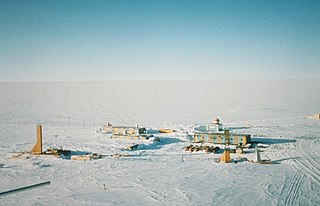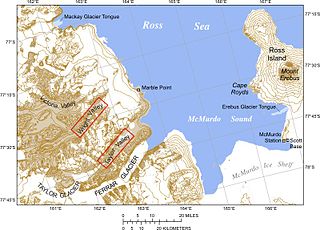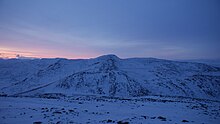Premenstrual syndrome (PMS) is a disruptive set of emotional and physical symptoms that regularly occur in the one to two weeks before the start of each menstrual period. Symptoms resolve around the time menstrual bleeding begins. Symptoms vary, though commonly include one or more physical, emotional, or behavioral symptoms, that resolve with menses. The range of symptoms is wide, and most commonly are breast tenderness, bloating, headache, mood swings, depression, anxiety, anger, and irritability. To be diagnosed as PMS, rather than a normal discomfort of the menstrual cycle, these symptoms must interfere with daily living, during two menstrual cycles of prospective recording. PMS-related symptoms are often present for about six days. An individual's pattern of symptoms may change over time. PMS does not produce symptoms during pregnancy or following menopause.

Vostok Station is a Russian research station in inland Princess Elizabeth Land, Antarctica. Founded by the Soviet Union in 1957, the station lies at the southern Pole of Cold, with the lowest reliably measured natural temperature on Earth of −89.2 °C. Research includes ice core drilling and magnetometry. Vostok was named after Vostok, the lead ship of the First Russian Antarctic Expedition captained by Fabian von Bellingshausen. The Bellingshausen Station was named after this captain.

The polar regions, also called the frigid zones or polar zones, of Earth are Earth's polar ice caps, the regions of the planet that surround its geographical poles, lying within the polar circles. These high latitudes are dominated by floating sea ice covering much of the Arctic Ocean in the north, and by the Antarctic ice sheet on the continent of Antarctica and the Southern Ocean in the south.

Polar night is a phenomenon that occurs in the northernmost and southernmost regions of Earth when the Sun remains below the horizon for more than 24 hours. This only occurs inside the polar circles. The opposite phenomenon, polar day or midnight sun, occurs when the Sun remains above the horizon for more than 24 hours.

Concordia Research Station, which opened in 2005, is a French–Italian research facility that was built 3,233 m (10,607 ft) above sea level at a location called Dome C on the Antarctic Plateau, Antarctica. It is located 1,100 km (680 mi) inland from the French research station at Dumont D'Urville, 1,100 km (680 mi) inland from Australia's Casey Station and 1,200 km (750 mi) inland from the Italian Zucchelli Station at Terra Nova Bay. Russia's Vostok Station is 560 km (350 mi) away. The Geographic South Pole is 1,670 km (1,040 mi) away. The facility is also located within Australia's claim on Antarctica, the Australian Antarctic Territory.

The McMurdo Sound is a sound in Antarctica, known as the southernmost passable body of water in the world, located approximately 1,300 kilometres (810 mi) from the South Pole.
Operation Deep Freeze is codename for a series of United States missions to Antarctica, beginning with "Operation Deep Freeze I" in 1955–56, followed by "Operation Deep Freeze II", "Operation Deep Freeze III", and so on.. Given the continuing and constant US presence in Antarctica since that date, "Operation Deep Freeze" has come to be used as a general term for US operations in that continent, and in particular for the regular missions to resupply US Antarctic bases, coordinated by the United States military. Task Force 199 was involved.
Rodney David Marks was an Australian astrophysicist who died from methanol poisoning while working in Antarctica.
Ellsworth K. Eric Gunderson, Ph.D. was a psychologist who has studied human adaptation to living and working under the conditions associated with isolation and confinement. He is an important contributor to the field of Antarctic psychology.

Plateau Station is an inactive American research and South Pole—Queen Maud Land Traverse support base on the central Antarctic Plateau. Construction on the site started on December 13, 1965, and the first traverse team arrived in early 1966. The base was in continuous use until January 29, 1969, when it was closed but mothballed for future use, and was the most remote and coldest of any United States stations on the continent. It was also the site for the world's coldest measured average temperature for a month at that time, recorded in July 1968, at −99.8 °F (−73.2 °C).

The South Pole, also known as the Geographic South Pole or Terrestrial South Pole, is the southernmost point on Earth and lies antipodally on the opposite side of Earth from the North Pole, at a distance of 20,004 km in all directions. It is one of the two points where Earth's axis of rotation intersects its surface.
Kunlun Station is the southernmost of five Chinese research stations in Antarctica. When it is occupied during the summer, it is the second-southernmost research base in Antarctica, behind only the American Amundsen–Scott South Pole Station at the geographical South Pole. When Kunlun is not in operation, the year-round Russian Vostok Station is the second-southernmost base in Antarctica.
Polar T3 syndrome is a condition found in polar explorers, caused by a decrease in levels of the thyroid hormone T3. Its effects include forgetfulness, cognitive impairment and mood disturbances. It can exhibit itself in a fugue state known as the Antarctic stare.

Psychological and sociological effects of space flight are important to understanding how to successfully achieve the goals of long-duration expeditionary missions. Although robotic spacecraft have landed on Mars, plans have also been discussed for a human expedition, perhaps in the 2030s, for a return mission.

Ulysses syndrome is an atypical set of depressive, anxious, dissociative, and somatoform symptoms that results from being exposed to extreme levels of stress unique to the process of modern migration. Rather than a mental disorder, this syndrome is a natural reaction to toxic levels of stress seen in migrants who are otherwise in normal mental health.

This is a Timeline ofwomen in Antarctica. This article describes many of the firsts and accomplishments that women from various countries have accomplished in different fields of endeavor on the continent of Antarctica.
While crime in Antarctica is relatively rare, isolation and boredom affect certain people there negatively and may lead to crime. Alcoholism is a known problem on the continent and has led to fights and indecent exposure. Other types of crime that have occurred in Antarctica include illicit drug use, torturing and killing wildlife, racing motorbikes through environmentally sensitive areas, assault with a deadly weapon, attempted murder and arson. Sexual harassment also has been reported.

Sleep is a naturally recurring state of mind and body, characterized by altered consciousness, relatively inhibited sensory activity, reduced muscle activity, and inhibition of nearly all voluntary muscles during rapid eye movement (REM) sleep, and reduced interactions with surroundings. An essential aspect of sleep is that it provides the human body with a period of reduced functioning that allows for the systems throughout the body to be repaired. This time allows for the body to recharge and return to a phase of optimal functioning. It is recommended that adults get 7 to 9 hours of sleep each night. Sleep is regulated by an internal process known as the circadian rhythm. This 24-hour cycle regulates periods of alertness and tiredness that an individual experiences. The correlation between psychological stress and sleep is complex and not fully understood. In fact, many studies have found a bidirectional relationship between stress and sleep. This means that sleep quality can affect stress levels, and stress levels can affect sleep quality. Sleep change depends on the type of stressor, sleep perception, related psychiatric conditions, environmental factors, and physiological limits.

Confined environment psychology is a refined subcategory of environmental psychology. There can be severe neurological impacts upon remaining in a confined environment over a prolonged period of time. Confined environment psychology can come in different forms, including; by location and lack of or limited human interaction. The broad subcategory also includes the effects of social isolation on animals.
Michele Eileen Raney is an American physician who was the first woman to over winter at an Antarctica inland station in 1979. Raney continued her association with the American Polar Society as a consultant, trainer and board member.












